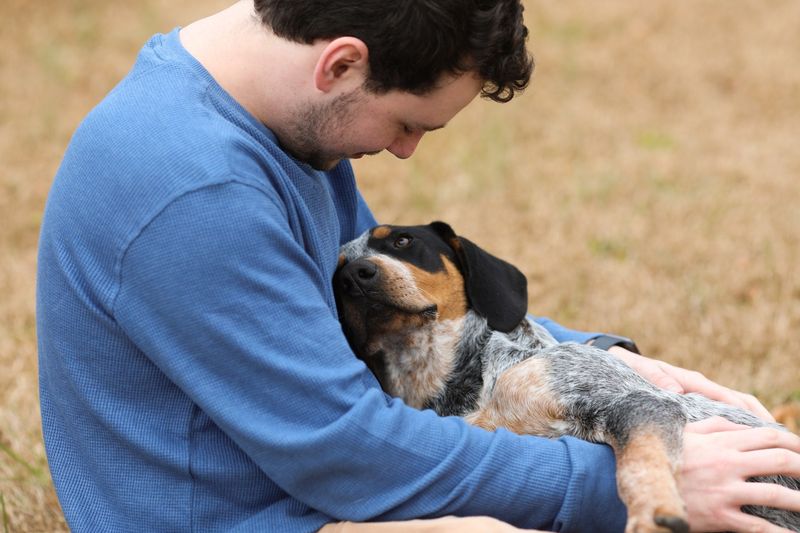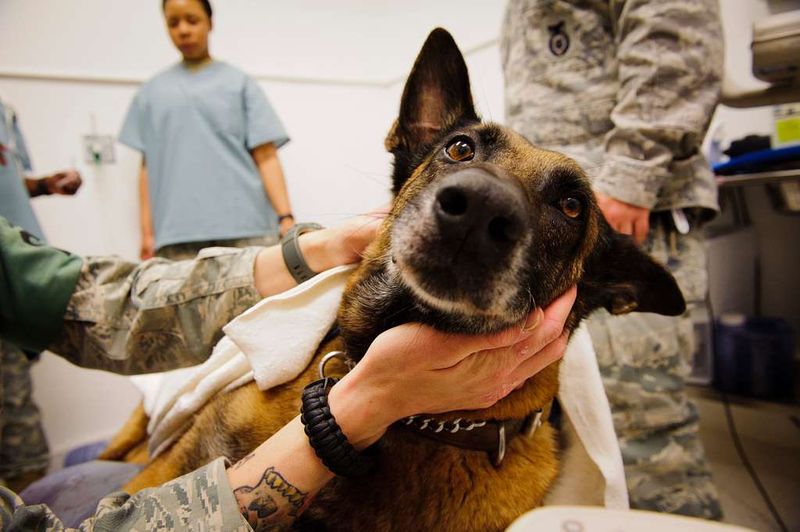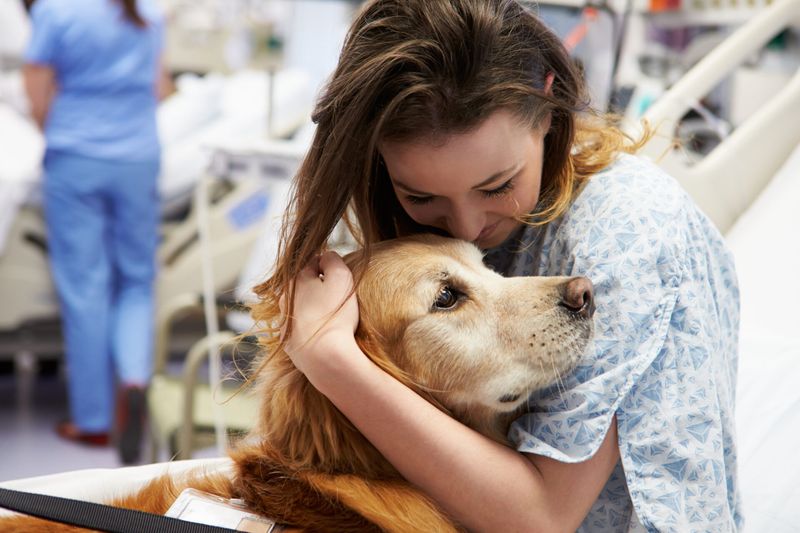As dogs approach the end of their life, they exhibit various emotional and behavioral changes. Understanding these signs can help pet owners provide comfort and support during their beloved pet’s final days. Each dog is unique, so not all signs will be present in every case. Here are 23 indicators to be aware of.
Loss of Appetite
One of the first signs a dog may exhibit when nearing the end is a loss of appetite. This change can be distressing to witness but is a common occurrence in aging dogs. They may approach their food bowl out of habit but show little interest in eating.
Sometimes, even favorite treats fail to entice them. This lack of hunger can lead to weight loss and a noticeable decline in energy. Consult with a veterinarian for advice on managing this symptom to ensure your pet remains as comfortable as possible.
Withdrawal from Family or Other Pets
A once-social dog may begin to withdraw from family and other pets as they near the end of their life. This behavior could be due to discomfort or a desire for solitude.
You might notice your dog spending time in quiet areas away from the usual household activity. It can be a peaceful retreat as they manage their pain or fatigue. Providing a calm and comfortable space for them can support their need for isolation and rest.
Changes in Breathing Patterns
Breathing patterns in dogs can change significantly as they near the end. This might manifest as shallow, rapid, or labored breathing. Such changes can be unsettling but are often part of the natural process.
Observing your pet for these signs can provide valuable information to share with your vet. Providing a cool, quiet environment might help ease any discomfort associated with breathing difficulties.
Unusual Fatigue or Sleepiness
Increased fatigue and sleepiness are common signs of a dog’s declining health. They might sleep more than usual, seeking rest over activity.
Previously active dogs may show little interest in playtimes or walks, preferring instead the comfort of their bed. This change in energy levels can indicate their body’s need to conserve strength as they approach their final days.
Difficulty Standing or Walking
Dogs nearing the end of life can experience difficulty standing or walking. This may be due to arthritis, muscle weakness, or neurological issues.
You might notice your pet stumbling, moving more slowly, or needing help to rise. Providing assistance with ramps or supportive harnesses can improve their mobility and comfort.
Seeking Solitude
Some dogs prefer solitude as they approach the end of life. They might retreat to quiet, hidden corners of the home, seeking peace away from noise and activity.
This behavior is a natural coping mechanism as they manage discomfort or confusion. Offering them a cozy, quiet space can help accommodate their need for solitude and ensure they feel secure.
Unresponsiveness to Familiar Commands
Unresponsiveness to commands they once knew well can be a sign that a dog is nearing the end of their life. This change may result from cognitive decline or simply a lack of energy.
Dogs that once eagerly obeyed might now seem indifferent or confused. Patience and understanding are key, as they may no longer have the cognitive or physical ability to respond as before.
Whining or Unusual Vocalizations
Whining or making unusual vocalizations can indicate discomfort or anxiety in a dog nearing the end of life. These sounds might be more frequent during the night or when they are trying to rest.
Understanding these vocal cues can help you gauge their comfort levels and provide appropriate care. Offering gentle reassurance and a soothing environment can be beneficial.
Sudden Clinginess
Some dogs exhibit sudden clinginess, desiring constant contact with their owner. This behavior can manifest as following you around or needing to be near you at all times.
This close companionship might be their way of seeking comfort and reassurance. Providing extra attention and affection can help ease their anxiety and offer a sense of security.
Loss of Bladder/Bowel Control
Loss of bladder or bowel control is a common symptom in dogs approaching the end of life. This may occur suddenly and without any previous issues.
Such incidents can be distressing for both the dog and owner. Providing supportive care with pads or frequent trips outside can manage these accidents compassionately.
Disorientation or Confusion
Disorientation or confusion can be signs of cognitive decline in elderly dogs. They might seem lost in familiar places or struggle to recognize family members.
This can be a disheartening change, but maintaining a consistent routine can provide stability. Gentle guidance and reassurance help them feel more secure in their environment.
Changes in Body Temperature
Changes in body temperature are not uncommon in dogs nearing the end of life. They may feel colder or warmer than usual to the touch, indicating changes in circulation or metabolism.
Ensuring they are comfortable with blankets or a warm bed can help regulate their temperature. Monitoring for signs of fever or chills is also essential.
Restlessness or Pacing
Restlessness and pacing can indicate discomfort or anxiety in dogs near the end of life. They may walk aimlessly or find it difficult to settle down.
This behavior might be their way of coping with pain or unease. Providing a calm and quiet environment, along with comforting reassurance, can help them relax.
Shivering or Trembling
Shivering or trembling can occur in dogs nearing the end due to pain, cold, or anxiety. It’s crucial to identify the underlying cause to offer appropriate care.
Providing warmth with blankets or soothing touch can calm them. Veterinary advice may be necessary to manage pain effectively if it’s a contributing factor.
Loss of Interest in Favorite Activities
A noticeable loss of interest in activities they once loved is common in aging dogs. They may ignore toys, avoid walks, or show little enthusiasm for play.
This change can signify a decline in their physical or mental well-being. Offering gentle engagement without pressure can still provide enjoyment and comfort.
Hiding in Unusual Places
Hiding in unusual places may indicate a dog’s desire to find peace or solitude in their final days. This behavior can be their way of managing discomfort or seeking a quiet retreat.
Allowing them access to safe, secluded areas can provide the comfort they need. Respecting their space during these times is crucial.
Staring Blankly or Avoiding Eye Contact
A dog approaching the end of life may stare blankly or avoid eye contact, reflecting confusion or a decline in cognitive abilities.
This behavior might be unsettling, but it can be a natural part of aging. Providing a calm and familiar environment can help them feel more grounded and secure.
Irregular Heartbeat
An irregular heartbeat can be a sign of declining health in a senior dog. It may result from heart disease or age-related changes, affecting their overall vitality.
Regular check-ups with a veterinarian are essential to monitor and manage this condition. Knowing their heart rhythm provides peace of mind and allows for timely interventions.
Reduced Tail Movement
Reduced tail movement in an aging dog can signal a lack of energy or a response to discomfort. A tail that once wagged joyfully may now remain still or move sluggishly.
This change can reflect their overall physical state. Gentle interaction and observation can ensure they remain comfortable and content.
Whimpering When Touched
Whimpering when touched might indicate pain or sensitivity in a dog nearing the end of life. This response can be due to arthritis, internal discomfort, or other health issues.
Careful handling and monitoring for specific pain areas can guide you in providing comfort. Consulting with a vet helps manage any underlying pain effectively.
Searching for Comfort from Owner
Some dogs actively seek comfort from their owners as they approach the end of life. They may lean against you, seek cuddles, or follow you closely.
This behavior is a testament to their trust and desire for reassurance during uncertain times. Providing love and support is crucial to help them feel safe and cherished.
Heavy Panting Without Exertion
Heavy panting without exertion can indicate discomfort or anxiety in an aging dog. It may result from pain, respiratory issues, or temperature regulation challenges.
Observing their breathing patterns and providing a cool environment can help them relax. Veterinary advice ensures any underlying issues are appropriately managed.
Calm Acceptance or Sudden Stillness
Some dogs exhibit a calm acceptance or sudden stillness as they approach the end of life. This serene demeanor might reflect their awareness and readiness.
While it can be comforting to witness, it often signals the natural process of saying goodbye. Providing a peaceful, loving environment helps them transition with dignity.























